Game
Explaining Game Stamina

Discover what the stamina mechanic is in video games, how it limits actions, and why it's a key element for adding strategic depth and challenge.
What is it?
Stamina, often visualized as a 'stamina bar' or meter, is a gameplay mechanic that represents a character's physical energy. It's a finite resource that is consumed when performing actions such as sprinting, dodging, attacking, or blocking. Once depleted, the character is often left temporarily vulnerable, unable to perform these actions until the meter regenerates over time. This system forces players to manage their energy output, preventing them from endlessly performing powerful moves and adding a layer of tactical resource management to the core gameplay loop.
Why is it trending?
Stamina mechanics have become a cornerstone of modern game design, particularly in action RPGs and survival games like the Souls series and Valheim. The trend is driven by a desire for more engaging and challenging experiences. Instead of allowing players to button-mash their way to victory, stamina systems require deliberate action and strategic thinking. This creates a compelling risk-versus-reward dynamic, where every dodge or attack has a cost. This added depth makes combat and exploration feel more consequential and rewarding, which resonates strongly with players seeking skillful gameplay.
How does it affect people?
For players, the stamina mechanic fundamentally changes how they approach a game. It introduces a rhythm to combat, forcing a pace of attack, retreat, and recovery. Players must become more observant, learning enemy patterns to know when it's safe to act and when to conserve energy. This fosters a more thoughtful and strategic playstyle, moving beyond pure reflexes. Mastering stamina management provides a significant sense of accomplishment and skill progression, making overcoming difficult challenges feel genuinely earned rather than a matter of brute force.